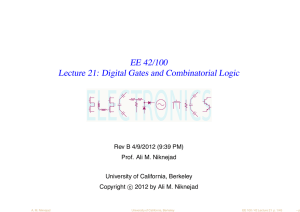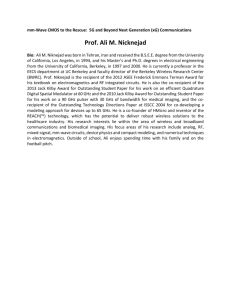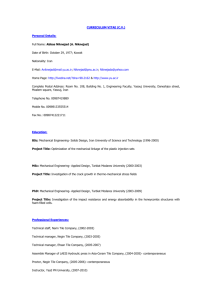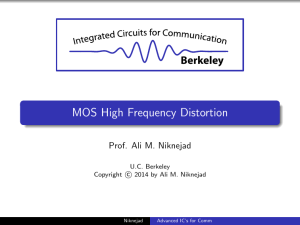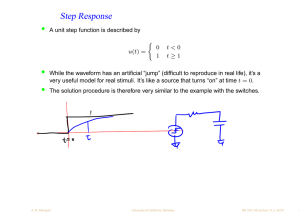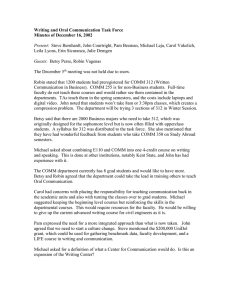Document 11094766
advertisement
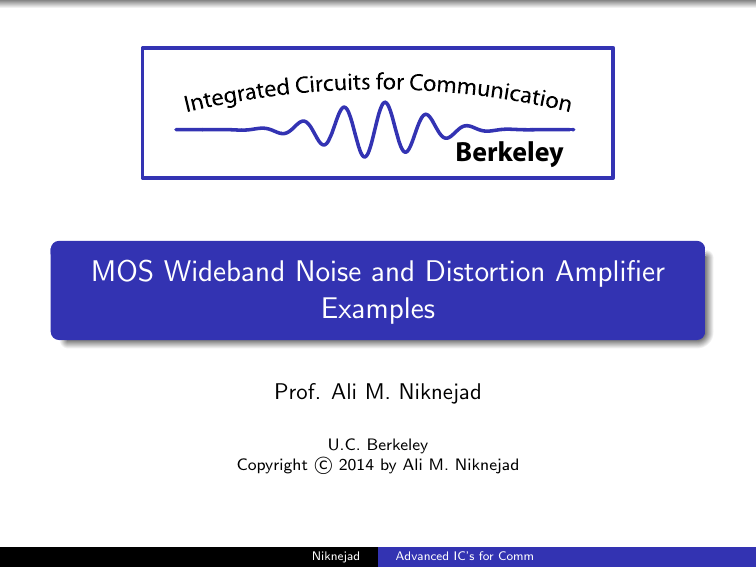
Berkeley MOS Wideband Noise and Distortion Amplifier Examples Prof. Ali M. Niknejad U.C. Berkeley c 2014 by Ali M. Niknejad Copyright Niknejad Advanced IC’s for Comm ching propdback . imum e well lable. from h for Wideband Noise Cancellation BRUCCOLERI et al.: WIDE-BAND CMOS LOW-NOISE AMPLIFIER EXPLOITING THERM IEEE JOURNAL OF SOLID-STATE CIRCUITS, VOL. 39, NO. 2, FEBRUARY 2004 gro is B. wh trib the A. Fig. 2. Matching MOSFET (a) noise and (b) signal voltage at nodes X and Y for the amplifier in Fig. 1(c) (biasing not shown). Take advantage of amplifier topologies where the output thermal noise flows into the input (CG amplifier, shunt feedback amplifer, etc). Cancel thermal noise using a second feedforward path. Can we also cancel the distortion? is larger than 1 NEF, as discussed in the previous section. Let us now analyze the signal and the noise voltages at the input node X and output node Y, both with respect to ground, due of the impedance-matching MOSFET. to the noise current and , Depending on the relation between flows out of the matching a noise current MOSFET through and [Fig. 2(a)], with . This current causes two instantaneous noise voltages at nodes X and Y, which have equal sign. On the other hand, the signal voltages at nodes X and Y have opposite sign [Fig. 2(b)], the Klumperink, B. Nauta, “Wide-Band Source: F. Bruccoleri, E.because A. M. is negative, assuming . This difference gain in sign for noise and signal makes it possible to cancel the CMOS Low-Noise Amplifier Exploiting Thermal Noise Canceling,” JSSC, noise of the matching device, while simultaneously adding the vol. 39, Feb. 2004. signal contributions constructively. This is done by creating a new output, where the voltage at node Y is added to a scaled Fig. 3. (a) Wide-band LNA exploiting noise canceling. (b) Elementary Advanced IC’soffor Comm implementation amplifier A plus adder (biasing not shown). (c) Matching negative replica of the voltage at node X. A proper Niknejad value for Up Th by ma tha dis EF Noise Cancellation LNA Motivated by [Bruccoleri, et al., ISSCC 2002] Niknejad Advanced IC’s for Comm 130nm LNA Prototype 130nm CMOS, 1.5V, 12mA Employ only thin oxide transistors W.-H. Chen, G. Liu, Z. Boos, A. M. Niknejad, “A Highly Linear Broadband CMOS LNA Employing Noise and Distortion Cancellation,” IEEE Journal of Solid-State Circuits, vol. 43, pp. 1164-1176, May 2008. Niknejad Advanced IC’s for Comm Measured LNA S-Parameters Matches simulations well. Very broadband performance. Niknejad Advanced IC’s for Comm Measured Noise Performance Noise cancellation is clearly visible. This is also a “knob” for dynamic operation to save current. Niknejad Advanced IC’s for Comm Measured Linearity Record linearity of +16 dBm for out of band blockers (at the time of publication). Linearity works over entire LNA band. Niknejad Advanced IC’s for Comm Linearity Bias Dependence As we vary the bias of key transistor, we simulate the effects of process/temp variation. There is a 50 mV window where the performance is still acceptable. Niknejad Advanced IC’s for Comm LNA Distortion Analysis TION CANCELATION DESIGN 59 R1 Vb1 Let’s assume that the drain current is a power-series of the Vgs voltage: V1 M1 gm’ current Cs Vx id = gm1 Vgs + C 12 Rs The purpose of the “differential” input is to cancel the 2nd order distortion of the first stage (to minimize 2nd order interaction): M2 Vs V2 Vb2 gm3 3 gm2 2 V + V 2! gs 3! gs R2 re 4.6: Circuit schematic to remove IM3 second-order interaction 0 − g0 00 + g 00 gmn gmn mp 2 mp 3 vin + vin 00 2 6 urrent generated by gm of both transistors, similar to that by gm as well as iout = ids,n +ids,p = (gmn + gmp ) vin + 00 currents are combined and oise, is departing from each other. With C12 , gm 0 of both transistors, or R1 in parallel with R2 . The current generated by gm Niknejad Advanced IC’s for Comm Distortion Equivalent Circuit MPLEMENTATION 68 R1 RL Vb1 Vb5 C 13 V1 Vout M1 Cs Rs M3 C 24 M2 Vs M5 C 12 Vx M4 Vx = A1 (s1 ) ◦ Vs + A2 (s1 , s2 ) ◦ Vs2 + A3 (s1 , s2 , s3 ) ◦ Vs3 V2 Vb2 Assume R1/R2 and RL are small so that ro non-linearity is ignored. V1 = B1 (s1 ) ◦ Vs + B2 (s1 , s2 ) ◦ Vs2 + B3 (s1 , s2 , s3 ) ◦ Vs3 R2 Vb3 Vb4 V2 = C1 (s1 ) ◦ Vs + C2 (s1 , s2 ) ◦ Vs2 + C3 (s1 , s2 , s3 ) ◦ Vs3 Vx − V2 Vx Vx − V1 Vs − Vx + im2 + + im1 + = ro1 independently through an external ro2voltage sourceZx (s) Zs (s) erization, each transistor is biased Vx − V1bias branch.VAC1coupling between V1 −stages V2was ed through on-chip diode-connected im1 + = + poly resistor was ented with the aid of capacitors ro1C , C and C Z. Low-value 1 (s) silicide Z 12 (s) for the resistors used in the schematic. Since a very high IIP is pursued, adding an Vx − V2 V2 V2 − V1 =was avoided. Otherwise + the measured im2for+50 ⌦ measurement setup output bu↵er ro2 Z2 (s) Z12 (s) Figure 5.1: Complete LNA schematic 13 24 Z1 = R1 || Zs = Rs + s 3 y will be easily colored by the intrinsic distortion of the bu↵er circuit itself. Therefore Niknejad This ow load resistance of 60 ⌦ was adopted to facilitate the linearity measurement. Advanced IC’s for Comm 1 sC1 Zx = 1 sCs 1 sCx Drain Current Non-Linearity Assuming that the gates of the input transistors are grounded at RF: 0 00 gm1 gm1 2 3 im1 = − gm1 (−Vx ) + (−Vx ) + (−Vx ) 2 6 g 00 g0 = gm1 Vx − m1 Vx2 + m1 Vx3 2 6 0 00 gm2 g im2 = gm2 Vx + Vx2 + m2 Vx3 2 6 Solve for first order Kernels from: A1 (s) − B1 (s) A1 (s) − C1 (s) A1 (s) 1 − A1 (s) + gm2 A1 (s) + + = ro1 ro2 Zx (s) Zs (s) A1 (s) − B1 (s) B1 (s) B1 (s) − C1 (s) + gm1 A1 (s) + = ro1 Z1 (s) Z12 (s) A1 (s) − C1 (s) C1 (s) C1 (s) − B1 (s) gm2 A1 (s) + = + ro2 Z2 (s) Z12 (s) gm1 A1 (s) + Niknejad Advanced IC’s for Comm Simplified First-Order At the frequency of interest, Z12 ∼ 0 and B1 ∼ C1 (Z1 (s) k Z2 (s)) + (ro1 k ro2 ) H(s) Z1 (s) k Z2 (s) A1 (s) B1 (s) = A1 (s) = Z1 (s)kZ2 (s)+(ro1 kro2 ) 1+(gm1 +gm2 )(ro1 kro2 ) Zs (s) 1+ H(s) = Zs (s) 1 + (gm1 + gm2 )(ro1 k ro2 ) + (Z1 (s) k Z2 (s)) + (ro1 k ro2 ) Zx (s) Niknejad Advanced IC’s for Comm Second-Order Terms Retaining only 2nd order terms in the KCL equations: gm1 A2 (s1 , s2 ) − gm2 A2 (s1 , s2 ) + gm1 A2 (s1 , s2 ) − gm2 A2 (s1 , s2 ) + 0 gm1 2 0 gm2 2 0 gm1 2 0 gm2 2 A1 (s1 )A1 (s2 ) + A1 (s1 )A1 (s2 ) + A1 (s1 )A1 (s2 ) + A1 (s1 )A1 (s2 ) + A2 (s1 , s2 ) − B2 (s1 , s2 ) ro1 A2 (s1 , s2 ) − C2 (s1 , s2 ) ro2 A2 (s1 , s2 ) − B2 (s1 , s2 ) ro1 A2 (s1 , s2 ) − C2 (s1 , s2 ) ro2 Niknejad = = + + A2 (s1 , s2 ) Zx (s1 + s2 ) B2 (s1 , s2 ) Z1 (s1 + s2 ) C2 (s1 , s2 ) Z2 (s1 + s2 ) + + Advanced IC’s for Comm = −A2 (s1 , s2 ) Zs (s1 + s2 ) B2 (s1 , s2 ) − C2 (s1 , s2 ) Z12 (s1 + s2 ) C2 (s1 , s2 ) − B2 (s1 , s2 ) Z12 (s1 + s2 ) Second-Order Kernels Solving above equations we arrive at: 1 (g 0 − g 0 )(r o1 k ro1 )Zs (s1 + s2 )A1 (s1 )A1 (s2 ) + 4A2 (s1 , s2 ) m1 m2 A2 (s1 , s2 ) = 2 H(s1 + s2 ) + 4H(s1 , s2 ) Z1 (s1 +s2 )kZ2 (s1 +s2 ) 1 0 0 − Z (s +s )kZ (s +s ) 2 (gm1 − gm2 )(ro1 k ro1 )Zs (s1 + s2 )A1 (s1 )A1 (s2 ) + 4B2 (s1 , s2 ) x 1 2 s 1 2 B2 (s1 , s2 ) = H(s1 + s2 ) + 4H(s1 , s2 ) Zs (s1 + s2 ) 1 4A2 (s1 , s2 ) = Z12 (s1 + s2 )A1 (s1 )A1 (s2 ) × 2 Z1 (s1 + s2 ) + Z2 (s1 + s2 ) 0 0 g ro1 Z2 (s1 + s2 ) − gm2 ro2 Z1 (s1 + s2 ) 0 0 (gm1 − gm2 )(ro1 k ro2 ) + m1 ro1 + ro2 4B2 (s1 , s2 ) = − 1 2 Z12 (s1 + s2 )A1 (s1 )A1 (s2 ) Z1 (s1 + s2 ) 1 Z1 (s1 + s2 ) + Z2 (s1 + s2 ) ro1 + ro2 Zs (s1 + s2 ) 0 gm1 ro1 Z2 (s1 + s2 ) + ro2 1 + + Zx (s1 + s2 ) 0 0 Zs (s1 + s2 ) gm2 ro2 (1 + gm1 ro1 ) + gm1 ro1 (1 + gm2 ro2 ) × Zs (s1 , s2 ) 1 × Z1 (s1 , s2 ) + Z2 (s1 , s2 ) ro1 + ro2 ! (ro1 + Z1 (s1 + s2 ))(ro2 + Z2 (s1 + s2 )) + (1 + gm1 ro1 ) ro2 + Z2 (s1 + s2 ) + (1 + gm2 ro2 ) ro1 + Z1 (s1 + s2 ) Zx (s1 + s2 ) k Zs (s1 + s2 ) 4H(s1 , s2 ) = Z12 (s1 + s2 ) Niknejad Advanced IC’s for Comm Third-Order Terms gm1 A3 (s1 , s2 , s3 ) + +gm2 A3 (s1 , s2 , s3 ) + =− 00 gm2 6 0 A1 (s1 )A1 (s2 )A1 (s3 ) − gm1 A1 (s1 )A2 (s2 , s3 ) + A1 (s1 )A1 (s2 )A1 (s3 ) + 0 gm2 A1 (s1 )A2 (s2 , s3 ) + A3 (s1 , s2 , s3 ) − B3 (s1 , s2 , s3 ) ro1 A3 (s1 , s2 , s3 ) − C3 (s1 , s2 , s3 ) ro2 Zs (s1 + s2 + s3 ) B3 (s1 , s2 , s3 ) Z1 (s1 + s2 + s3 ) gm2 A3 (s1 , s2 , s3 ) + = 6 A3 (s1 , s2 , s3 ) gm1 A3 (s1 , s2 , s3 ) + = 00 gm1 C3 (s1 , s2 , s3 ) Z2 (s1 + s2 + s3 ) 00 gm1 6 + 00 gm2 6 + 0 A1 (s1 )A1 (s2 )A1 (s3 ) − gm1 A1 (s1 )A2 (s2 , s3 ) + A3 (s1 , s2 , s3 ) − B3 (s1 , s2 , s3 ) ro1 B3 (s1 , s2 , s3 ) − C3 (s1 , s2 , s3 ) Z12 (s1 + s2 + s3 ) 0 A1 (s1 )A1 (s2 )A1 (s3 ) + gm2 A1 (s1 )A2 (s2 , s3 ) + A3 (s1 , s2 , s3 ) − C3 (s1 , s2 , s3 ) C3 (s1 , s2 , s3 ) − B3 (s1 , s2 , s3 ) Z12 (s1 + s2 + s3 ) Niknejad Advanced IC’s for Comm ro1 Third-Order Kernel Assuming Z12 ∼ 0 (at s1 + s2 + s3 ): A3 (s1 , s2 , s3 ) = 0 + g 0 )A (s )A (s , s ) + 1 (g 00 + g 00 )A (s )A (s )A −Zs (ro1 k ro2 ) − (gm1 1 1 2 2 3 1 1 1 2 1 m2 m2 6 m1 H(s1 + s2 + s3 ) −Z1 (s1 + s2 + s3 ) B3 (s1 , s2 , s3 ) = A3 (s1 , s2 , s3 ) Zx (s1 + s2 + s3 ) k Zs (s1 + s2 + s3 ) Niknejad Advanced IC’s for Comm Output Voltage The output voltage is given by a new Volterra series. Assume for simplicity the following: Vout = gm3 V1 + gm4 Vx + 0 g0 g 00 g 00 gm3 V12 + m4 Vx2 + m3 V13 + m4 Vx3 2 2 6 6 × ZL The fundamental and third-order output are therefore: Vout,fund = (A1 (s) ◦ Vs ) × gm4 + (B1 (s) ◦ Vs ) × gm3 × ZL Vout,3rd = (A3 (s1 , s2 , s3 ) ◦ Vs3 ) × gm4 + (B3 (s1 , s2 , s3 ) ◦ Vs3 ) × gm3 + (A1 (s) ◦ Vs )3 × 00 g 00 gm4 + (B1 (s) ◦ Vs )3 × m3 6 6 0 0 + (A1 (s1 )A2 (s2 , s3 ) ◦ Vs3 ) × gm4 + (B1 (s1 )B2 (s2 , s3 ) ◦ Vs3 ) × gm3 Niknejad Advanced IC’s for Comm × ZL Focus on Third-Order Output At low frequencies: A1 /B1 ∼ Rin /R1 A2 /B2 ∼ −Rs /R1 A3 /B3 ∼ −Rs /R1 Vout,3rd = (A3 (s1 , s2 , s3 ) ◦ Vs3 ) × gm4 + (B3 (s1 , s2 , s3 ) ◦ Vs3 ) × gm3 + (A1 (s) ◦ Vs )3 × 00 gm4 g 00 + (B1 (s) ◦ Vs )3 × m3 6 6 0 0 + (A1 (s1 )A2 (s2 , s3 ) ◦ Vs3 ) × gm4 + (B1 (s1 )B2 (s2 , s3 ) ◦ Vs3 ) × gm3 × ZL First term cancels like thermal noise Second term: New distortion generated at output. Cancel with MGTR. Thrid term: Due to second-order interaction: Must use g 0 = 0 Niknejad Advanced IC’s for Comm Two-Tone Spacing Dependence Because 2nd order interaction is minimized by using a PMOS and NMOS in parallel, the capacitor C12 plays an important role. When second order distortion is generated at low frequencies, f1 − f2 , the capacitor C12 has a high reactance and distortion cancellation does not take place. There is therefore a dependency to the two-tone spacing. Niknejad Advanced IC’s for Comm Power Supply Ripple In RF systems, the supply ripple can non-linearity transfer noise modulation on the supply to the output. This problem was analyzed by Jason Stauth: Energy Efficient Wireless Transmitters: Polar and Direct-Digital Modulation Architectures, Ph.D. Dissertation, U.C. Berkeley. Niknejad Advanced IC’s for Comm Supply Noise Sources Niknejad Advanced IC’s for Comm Multi-Port Memoryless Non-linearity The output voltage is a non-linear function of both the supply voltage and the input voltage. A two-variable Taylor series expansion can be used if the system is memory-less: Sout (Sin , Svdd ) = a10 Sin + a20 Sin2 + a30 S3in + · · · +a11 Sin Svdd + a21 Sin2 Svdd + · · · 2 3 +a01 Svdd + a02 Svdd + a03 Svdd + ··· Niknejad Advanced IC’s for Comm Supply Noise Sideband Assume the input is at RF and the supply noise is a tone. Then the output signal will contain a noise sideband given by: Sin = vi cos(ω0 t) Svdd = vs cos(ωs t) 1 vout (ω0 ± ωs ) = a11 vi vs 2 2a10 1 Sideband(dBc) = dB · a11 vs 2a10 PSSR = dB a11 Niknejad Advanced IC’s for Comm Multi-Port Volterra Series Extending the concept of a Volterra Series to a two input-port system, we have vout (t) = ∞ ∞ X X Fmn (v1 (t), v2 (t)) m=0 n=0 Z ∞ Fmn (v1 (t), v2 (t)) = −∞ ··· Z ∞ −∞ hmn (τ1 , · · · , τm+n ) v1 (t − τ1 ) · · · v1 (τ − τm )v2 (t − τm+1 ) · · · v2 (τ − τm+n ) ×dτ1 · · · dτm+n Sout = A10 (jωa )◦ S1 + A20 (jωa , jωb )◦ S12 + A30 (jωa , jωb , jωc )◦ S13 + · · · +A01 (jωa )◦ S2 + A02 (jωa , jωb )◦ S22 + A03 (jωa , jωb , jωc )◦ S23 + · · · ◦ +A11 (jωa , jωb ) S1 S2 + A21 (jωa , jωb , jωc )◦ S12 S2 + A12 (jωa , jωb , jωc )◦ S1 S22 + · · · Niknejad Advanced IC’s for Comm Example 2 3 id = gm1 vgs + gm2 vgs + gm3 vgs + ··· 2 3 −gmb1 vsb − gmb2 vsb − gmb3 vsb + ··· 2 2 +gmo11 vds · vgs + gmo12 vds · vgs + gmo21 vds vgs + · · · +C1 d C2 d 2 C3 d 3 (vdb ) + (v ) + (v ) + · · · dt 2 dt db 3 dt db Several important terms: gm , and go non-linearity is usual transconductance and output resistance terms gmo is the interaction between the input/output Cj is the output voltage non-linear capacitance Niknejad Advanced IC’s for Comm First Order Terms y1 (jω) = g o1 + jωC yx (jω) = (jωLC )−1 ys (jω) = (jωLs )−1 First-order transfer function: (RF Node Transfer) gm1 A110 (jω) = −ys (jω) K0 (jω) K0 (jω) = (gm1 + gmb1 + y1 )(yx + yL ) + ys (yx + y1 + yL ) Supply Node Transfer: (superscripts are node numbers) gm1 (yx + yL ) A101 (jω) = K0 (jω) y (g m + y + gmb x 1 1 1 + ys ) A210 (jω) = K0 (jω) yx yL A201 (jω) = K0 (jω) Niknejad Advanced IC’s for Comm Mixing Product The most important term for now is the supply-noise mixing term: vout (ω0 ± ωs ) = A111 (jω0 , jωs )◦ [Vi (ω0 ), Vs (ωs )] A111 (jωa , jωb ) = ys gmo11 K1 + 2y2 K2 + 2g m2 K3 − 2gmb2 K4 K0 K1 (jωa , jωb ) = A201 [1 + A110 (jωa ) − 2A210 (jωa )] − A101 (jωb )[1 − A210 (jωa )] K2 (jωa , jωb ) = A201 (jωB )[A110 (jωa ) − A210 (jωa )] + A101 (jωb )[A210 (jωa ) − A110 (jωa )] K3 (jωa , jωb ) = A201 (jωb )[1 − A110 (jωa )] K4 (jωa , jωb ) = A210 (jωa )A201 (jωb ) Niknejad Advanced IC’s for Comm PSSR Reduction PSRR = dB[ g m1 ] gmo11 K1 + 2y2 K2 + 2g m2 K3 − 2gmb2 K4 Increase gm1 Reduce second order conductive non-linearity at drain (go2 ) Reduce the non-linear junction capacitance at drain Reduce cross-coupling term by shielding the device drain from supply noise (cascode) Niknejad Advanced IC’s for Comm Output Conductance Non-Linearity For short-channel devices, due to DIBL, the output has a strong influence on the drain current. A complete description of the drain current is therefore a function of f (vds , vgs ). This is especially true if the device is run close to triode region (large swing or equivalently high output impedance): 2 2 ids (vgs , vds ) = gm1 vgs + gds1 vds + gm2 vgs + gds2 vds + 3 3 + gds3 vds + x11 vgs vds + gm3 vgs 2 2 x12 vgs vds + x21 vgs vds + · · · gmk = 1 ∂ k Ids 1 ∂ k Ids 1 ∂ p+q Ids ; gdsk = ; xpq = p q k k k! ∂Vgs k! ∂Vds p!q! ∂Vgs ∂Vgs Niknejad Advanced IC’s for Comm Total Distortion Including the output conductance non-linearity modifies the distortion as follows 2 + c v3 + · · · vds = c1 vgs + c2 vgs 3 gs −1 c1 = −gm1 (RCS ||gds1 ) −1 c2 = −(gm2 + gds2 c12 + x11 c1 ) · (RCS ||gds1 ) 3 c3 = −(gm3 + gds3 c1 + 2gds2 c1 c2 + x11 c2 + x12 c12 + x21 c1 ) · (RCS ||g Source: S. C. Blaakmeer, E. A. M. Klumperink, D. M. W. Leenaerts,, B. Nauta, “Wideband Balun-LNA With Simultaneous Output Balancing, Noise-Canceling and Distortion-Canceling,” JSSC, vol. 43, Jun. 2008. Niknejad Advanced IC’s for Comm Example IIP Simulation Contributions to c2 are shown above. For low bias, gds2 contributes very little but x11 and gm2 are significant. They also have opposite sign. Niknejad Advanced IC’s for Comm PA Power Supply Modulation When we apply a 1-tone to a class AB PA, the current drawn from the supply is constant. For when we apply 2-tones, there is a low-frequency component to the input: Vin = A sin(ω1 t) + A sin(ω2 t) ω1 + ω2 ω1 − ω2 t sin t = 2A cos 2 2 = 2A cos(ωm t) sin(ωc t) This causes a low frequency current to be drawn from the supply as well, even for a balanced circuit. P. Haldi, D. Chowdhury, P. Reynaert, G. Liu, A. M Niknejad, “A 5.8 GHz 1 V Linear Power Amplifier Using a Novel On-Chip Transformer Power Combiner in Standard 90 nm CMOS,” IEEE Journal of Solid-State Circuits, vol. 43, pp.1054-1063, May 2008. Niknejad Advanced IC’s for Comm Supply Current The supply current is a full-wave rectified sine. Niknejad Advanced IC’s for Comm Fourier Components of Supply Current Substitute the Fourier series for the sine and cosine. Note that an on-chip bypass can usually absorb the higher frequencies (2fc ) but not the low frequency beat (fs and harmonics) 4 cos(2ωm t) 2 4 cos(2ωc t) 2 + − ··· × − − ··· is = k π π 3 π π 3 8 cos(2ωc t) 8 cos(2ωm t) = k ··· − 2 + 2 − ··· π 3 π 3 8 cos(ωs t) 8 cos(2ωc t) + 2 − ··· = k ··· − 2 π 3 π 3 Niknejad Advanced IC’s for Comm Supply Ripple Voltage The finite impedance of the supply means that the supply ripple has the following form. Vdd = VDD + A2 · cos(ωs t) + · · · Assuming a multi-port Volterra description for the transistor results in: So = F1 (ωa )◦ S1 + F2 (ωa , ωb )◦ S12 + F3 (ωa , ωb , ωc )◦ S13 + · · · G1 (ωa )◦ S2 + G2 (ωa , ωb )◦ S22 + G3 (ωa , ωb , ωc )◦ S33 + · · · H11 (ωa , ωb )◦ (S1 · S2 ) + H12 (ωa , ωb , ωc )◦ (S1 · S22 )+ H21 (ωa , ωb , ωc )◦ (S12 · S2 ) + · · · S(ω1 ± ωs ) = H11 ◦ (S1 · S2 ) Niknejad Advanced IC’s for Comm Experimental Results Even though the PA is fully balanced, the supply inductance impacts the linearity. Measurements confirm the source of the IM3 at low offsets arising from supply modulation. Niknejad Advanced IC’s for Comm MOS CV Non-Linearity Cox u act al VF B VT Cgs , Cµ and Cdb all contribute to the non-linearity. As expected, the contribution is frequency dependent and very much a strong function of the swing (drain, gate). Gate cap is particular non-linear around the threshold of the device. Niknejad Advanced IC’s for Comm PMOS Compensation Technique Make an overall flat C -V curve by adding an appropriately sized PMOS device. Source: C. Wang, M. Vaidyanathan, L. Larson, “A Capacitance-Compensation Technique for Improved Linearity in CMOS Class-AB Power Ampliers,” JSSC, vol. 39, Nov. 2004. Niknejad Advanced IC’s for Comm Jiashu 2:1 1V 30fF 600fF 1V G 2:1 2.2µm 1x PPD control 6.6µm 6.6µm 11µm 2x 8µm 20µm bbl<0> S PPD 13µm bbe<0> G 24µm 24µm 40µm Early PA array bbe<0> bbe<1> bbe<2> bbe<3> Late PA array identical bbe<3:0> bbl<3:0> “Digital” PA cell at 60 GHz uses non-binary weighted elements for RF-DAC to compensate for amplitude compression. Phase AM-to-PM distortion is compensated by switching in capacitance versus codeword. Source: Jiashu Chen, Lu Ye, D. Titz, F. Gianesello, R. Pilard, A. Cathelin, F. Ferrero, C. Luxey, A. Niknejad, “A digitally modulated mm-Wave cartesian beamforming transmitter with quadrature spatial combining,” IEEE International Solid-State Circuits Conference Digest of Technical Papers (ISSCC), 17-21 Feb. 2013, pp. 232-233. Niknejad Advanced IC’s for Comm
